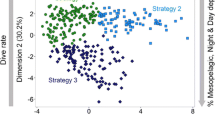Abstract
Synchronizing behavior with other conspecifics has been suggested as serving a function of increased foraging efficiency. However, the potential costs associated with synchronization of behavior have rarely been studied. Adélie penguins Pygoscelis adeliae sometimes dive synchronously in small open waters surrounded by fast sea ice. We examined the diving behavior of three couples and one trio, which were observed to dive synchronously among groups of 12–47 birds for 1.7–4.5 h duration, with time-depth recorders. Timing of diving and surfacing differed slightly between individuals, and one bird tended to initiate diving earlier than the other. Although the duration of the dives differed only slightly between these birds, the maximum depth of the dives differed to a large extent, with one member tending to dive consistently deeper than the other bird in two out of the four cases. Vertical distances between tagged birds in the undulatory phases of the dives (presumed feeding time) were greater than those in the descent and ascent phases, suggesting independent foraging by group members. Duration of the undulatory phase of the dives tended to be shorter in deeper-diving individuals than the others in the synchronously diving group, suggesting a potential cost of reduced feeding time to synchronize diving and surfacing with other birds. A digital video image relating to the article is available at http://www.momo-p.com/showdetail-e.php?movieid=momo030605pa01a.



Similar content being viewed by others
References
Ainley DG (1972) Flocking in Adélie penguins. Ibis 114:388–390
Ainley DG (2002) The Adélie penguin: bellwether of climate change. Columbia University Press, New York
Bannasch R, Wilson RP, Culik B (1994) Hydrodynamic aspects of design and attachment of a back-mounted device in penguins. J Exp Biol 194:83–96
Beauchamp G (1998) The effects of group size on mean food intake rate in birds. Biol Rev 73:449–472
Beauchamp G (2002) Higher-level evolution of intraspecific flock-feeding in birds. Behav Ecol Sociobiol 51:480–487
Bélisle M (1998) Foraging group size: models and a test with jaegers kleptoparasitizing terns. Ecology 79:1922–1938
Cobley ND, Bell G (1998) Weddell seal (Leptonychotes weddellii) feeding on gentoo penguins (Pygoscelis papua). Mar Mamm Sci 14:881–883
Conradt L, Roper TJ (2000) Activity synchrony and social cohesion: a fission-fusion model. Proc R Soc Lond B 267:2213–2218
Endo Y, Asari H, Watanuki Y, Kato A, Kuroki M, Nishikawa J (2002) Biological characteristics of euphausiids preyed upon by Adélie penguins in relation to sea ice condition in Lützow-Holm Bay, Antarctica. Polar Biol 25:730–738
Götmark F, Winkler DW, Andersson M (1986) Flock-feeding on fish schools increases individual success in gulls. Nature 319:589–591
Hiruki LM, Schwartz MK, Boveng PL (1999) Hunting and social behaviour of leopard seals (Hydrurga leptonyx) at Seal Island, South Shetland Islands, Antarctica. J Zool 249:97–109
Krause J, Ruxton GD (2002) Living in groups. Oxford University Press, Oxford
McMahon BF, Evans RM (1992) Foraging strategies of American white pelicans. Behaviour 120:69–89
Mori Y (1998) Optimal choice of foraging depth in divers. J Zool 245:279–283
Naito Y (1997) Development of micro data tag for study of free-ranging marine animals. Mem Fac Fish Hokkaido Univ Spec Edn 44:31–34
O’Brien DP (1987) Direct observations of the behavior of Euphausia superba and Euphausia crystallorophias (Crustacea: Euphausiacea) under pack ice during the Antarctic spring of 1985. J Crust Biol 7:437–448
Rogers T, Bryden MM (1995) Predation of Adélie penguins (Pygoscelis adeliae) by leopard seals (Hyrurga leptonyx) in Prydz Bay, Antarctica. Can J Zool 73:1001–1004
Ropert-Coudert Y, Kato A, Baudat J, Bost C-A, Le Maho Y, Naito Y (2001) Feeding strategies of free-ranging Adélie penguins Pygoscelis adeliae by multiple data recording. Polar Biol 24:460–466
Ruckstuhl KE (1999) To synchronize or not to synchronize: a dilemma for young bighorn males? Behaviour 136:805–818
Saino N, Fasola M, Waiyaki E (1995) Do white pelicans Pelecanus onocrotalus benefit from foraging in flocks using synchronous feeding? Ibis 137:227–230
Siegfried WR, Frost PGH, Kinahan JB, Cooper J (1975) Social behaviour of jackass penguins at sea. Zool Afr 10:87–100
Todd FS (1988) Weddell seal preys on chinstrap penguin. Condor 90:249–250
Tremblay Y, Cherel Y (1999) Synchronous underwater foraging behavior in penguins. Condor 101:179–185
Watanuki Y, Kato A, Naito Y, Robertson G, Robinson S (1997) Diving and foraging behaviour of Adélie penguins in areas with and without fast sea-ice. Polar Biol 17:296–304
Watanuki Y, Kato A, Sato K, Niizuma Y, Bost C-A, Le Maho Y, Naito Y (2002) Parental mass change and food provisioning in Adélie penguins rearing chicks in colonies with contrasting sea-ice conditions. Polar Biol 25:672–681
Wilson RP (1995) Foraging ecology. In: Williams TD (ed) The penguins. Oxford University Press, Oxford, pp 81–106
Wilson RP, Wilson M-P, McQuaid L (1986) Group size in foraging African penguins (Spheniscus demersus). Ethology 72:338–341
Zar, J.H. (1999) Biostatistical analysis, 4th edn. Prentice Hall, N.J.
Acknowledgements
We would like to thank all the members of JARE 40th and the crew of icebreaker ‘Shirase’ for their logistic support. Thanks are also due to Richard Phillips, Mark Jessopp, Yoshihisa Mori, Kensuke Nakata, Shinji Yabuta and the editors Kazuki Tsuji and Yukio Yasui for their thoughtful and constructive comments, which greatly improved the manuscript. This study was conducted through the SIPENS (Sea Ice and Penguin Study) program organized by the National Institute of Polar Research, and supported by a Grant-in-Aid from the Japan Society for the Promotion of Science (14405027 and 15255003). A.T. was partly supported by JSPS Postdoctoral Fellowship Research Abroad (at British Antarctic Survey) during writing of the paper.
Author information
Authors and Affiliations
Corresponding author
About this article
Cite this article
Takahashi, A., Sato, K., Nishikawa, J. et al. Synchronous diving behavior of Adélie penguins. J Ethol 22, 5–11 (2004). https://doi.org/10.1007/s10164-003-0111-1
Received:
Accepted:
Published:
Issue Date:
DOI: https://doi.org/10.1007/s10164-003-0111-1




